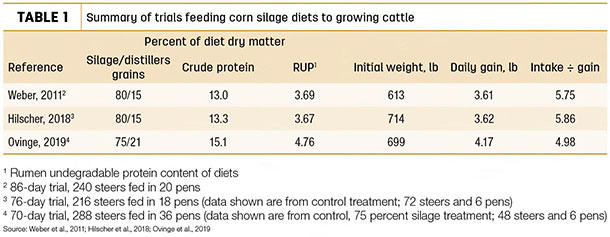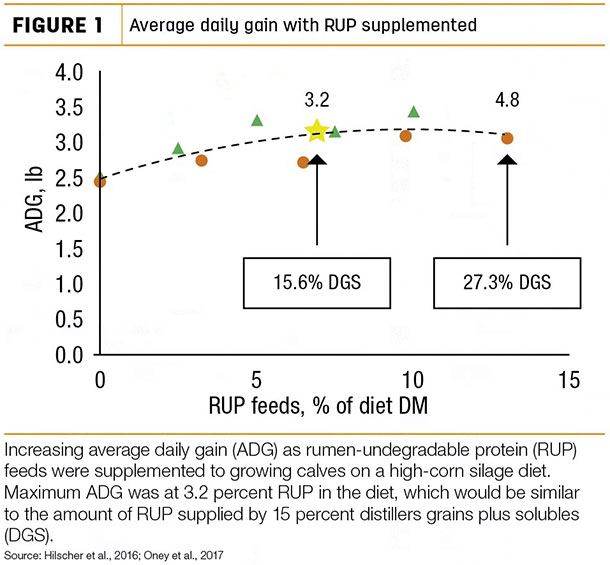With this wide range in feedstuffs, formulating diets to meet nutrient requirements becomes very important, especially for young, growing cattle that have high protein requirements.
Most growing diets are forage-based. While forages can have fairly high crude protein (CP) levels, the majority is rumen-degradable protein, meaning it is broken down and utilized by microbes within the cattle’s first stomach, or rumen. The growing calf also requires protein that is not broken down within the rumen (rumen-undegradable protein or RUP) and supplies amino acids to the animal for growth.
Accurately measuring the RUP content of corn silage has been challenging. Lab techniques designed to measure RUP values of feedstuffs are specific to either forages or grains, and corn silage is a blend of both. The moisture content of the corn silage also impacts the degradability of the protein (wetter corn silage has a lower RUP content), and the protein continually becomes more degradable with longer ensiling times.
Thus, RUP content of corn silage is a moving target. Two experiments using fistulated steers and in-situ bags measured the RUP content of corn silage by breaking the silage down into forage and grain. Results suggest the RUP content of corn silage is 10 percent of the CP, meaning the CP within corn silage is 90 percent rumen-degradable.
Therefore, corn silage growing diets are deficient in RUP for growing calves. This is clearly demonstrated by two trials. They fed a 79 percent corn silage diet to 590-pound growing steers. Three treatments were evaluated, cattle supplemented 1.43 percent urea, 9.2 percent soybean meal with 9.6 percent ground corn or 18 percent distillers grains plus solubles (DGS).
The CP of all diets was 10.7 percent, and cattle gained 2.9, 3.39 and 3.45 pounds per day for the urea, soybean meal and DGS diets, respectively. Within this trial, feed conversion (pounds of feed needed to put on a pound of gain) improved from 5.29 for the urea treatment to 4.74 for the DGS treatment.
In the second trial, cattle were fed a 90 percent corn silage diet with 1.37, 1.74 or 2.11 percent urea. This increased CP of the diet from 12.9 to 15.4 percent and resulted in a linear increase in feed conversion (5.8 to 6.15) as urea in the diet increased. Supplying equal or even greater amounts of CP does not result in improved performance, and correctly formulating diets is critical.
At this time, DGS are the most economical way to provide RUP in cattle diets. Feeding corn silage with DGS will promote good growth (up to 4 pounds daily gain) fairly efficiently.
Comparing three trials feeding up to 21 percent DGS in corn silage growing diets shows increased gain and efficiency as DGS in the diet increased (Table 1).

These treatments have not been evaluated within the same trial; however, it appears blending corn silage and DGS gives great opportunity to program feed or target a desired level of gain.
The response to DGS in these trials is due to both its energy and RUP content. Therefore, two trials were done with individually fed cattle to evaluate the response to increasing amounts of a more concentrated RUP supplement (Figure 1).

The supplement was a blend of SoyPass (50 percent CP; 75 percent of CP is RUP) and Empyreal (Cargill Corn Milling, Blair, Nebraska; 75 percent CP; 65 percent of CP is RUP). Between the two trials, nine levels of supplement were offered from zero to 13 percent of diet dry matter. The highest level of supplement provided 4.8 percent of the diet as RUP (dry matter basis).
With the combined data, there was a quadratic increase in daily gain as supplement increased, with a peak at approximately 3.2 percent RUP. This would be similar to the amount of RUP supplied if 15 percent DGS were included in the diet.
Interim weight measurements suggest this response was even more apparent early in the feeding period, when requirements of growing calves are greatest. The first 30 days of a growing period are a critical time for RUP supplementation.
With high-quality corn silage and a little protein, calves can grow at a rate approaching 3 pounds per day, utilizing DGS to provide some of the CP, as RUP can increase gain beyond 3.5 pounds per day.
Formulating diets to meet the requirements of cattle is very important in order to be able to optimize the blend of corn silage and DGS and reach target bodyweight gains. This is especially true early in the growing period, when requirements are greatest. ![]()
References omitted but are available upon request. Click here to email an editor.

-
Andrea Watson
- Research Assistant Professor
- University of Nebraska – Lincoln
- Email Andrea Watson








